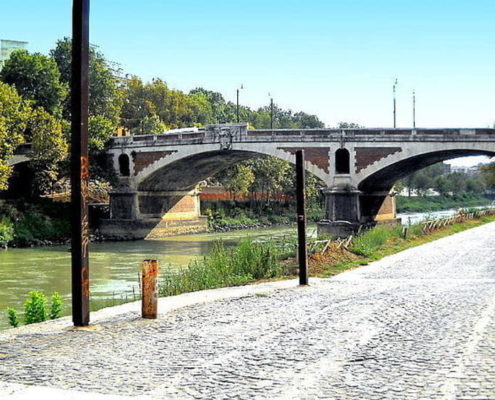The “marmorari” reused the ancient marbles and in particular the Egyptian red porphyry, the green serpentine of Sparta and the ancient yellow of Numidia, they paved churches and cloisters creating “carpets” with series of spiraling and circular elements called “conce”, the result? An anthology of circles, triangles, rhombuses and spirals that only today has turned out to be a real code with a very precise symbolic meaning that scholars are deciphering with great difficulty.
About the marble craftsmen called in Rome “marmorari”, not far from the Aventine, walking along Viale Aventino to the right of the Pyramid towards the Lungotevere is Via Marmorata, and the toponym reminds us that in the Middle Ages the old Roman warehouses became deposits of marble for which the “marmorari’s” settled right there their shops, right near the Emporium.
Via Marmorata is the street of the rationalist architecture of the Post Office created by Adalberto Libera in 1933, is the way of a famous gastronomy in which you enter and taste delicious butchers and cheeses; is the way that immediately after the Pyramid of Cestius, on the left proceeding towards the Tiber, flanks a low building dating back to the end of ‘700, today anonymous and small tenement, but once a powder magazine of the Castel Sant’Angelo bombardiers who practiced on the hill of Testaccio ; it is the road that leads to the Sublicio bridge which was the first wooden bridge built by the Romans; Via Marmorata is the access to Testaccio and its Monte dei Cocci … ah the Monte dei Cocci one of the many places unknown to the Romans!
On request, the “clavigero” literally the “key-holder” sent by the Superintendency opens an anonymous gate from which is possible to slowly advance along a path that leads to the summit of this artificial hill, created over the centuries with the accumulation of the remains of the amphorae that arrived by ship at the ‘Emporio, from every remote corner of the Mediterranean.
Each boat headed to the Emporio, transported loads of amphorae containing wine and oil, thousands of amphorae that would have required a long time for cleaning and reuse, and that emptied of their contents, however, would have constituted a weight for the boats that from Rome sailed against the wind towards the southern provinces of the Mediterranean, so the amphorae they were all threw themselves in the same place for convenience! The sedimentation of these materials, originated an artificial hill about 36 meters high composed precisely of the fragments of terracotta, a hill that in reality was a real landfill and that today is a basin of precious archaeological information; walking on the shards produces a strange sensation: how many hands have the clay kneaded? How many have they modeled it and then cooked it? How many have they marked, filled, aligned, emptied and then shattered on other “cocci”-shards? Even a Roman dump, thanks to the remains stamped with seals and stamps, tells stories of a laborious and thriving daily.
This part of Rome and its rarefied atmospheres is a few meters away from a piece of Ancient Rome and then from the medieval Rome and then from a still popular Rome, a Rome known for the post-war period, the market of Testaccio and the “testaccini” that proudly joined the trasteverini and monticiani, genuine custodians of a true and authentic Romanity.







